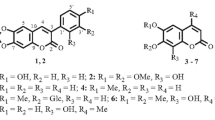Abstract
Thirteen natural and synthetic phenylpropanoids as well as coumarin (2×104M) were tested for their biological activity on radish germination and subsequent root growth in light and darkness. Coumarin was the most potent inhibitor. With some exceptions, phenylpropanoids with a carboxylic group in the side chain inhibited root growth. Coumarin was formed spontaneously by photooxidation of 2-hydroxycinnamic acid. Microscopic observations of root treated with coumarin suggest that this substance inhibits the elongation of cells of the differentiating zone of the root.
Similar content being viewed by others
References
Aliotta, G., Molinaro, A., Monaco, P., Pinto, G., Pollio, A., andPrevitera, L. 1992a. Three biologically active phenylpropanoid glucosides fromMyriophyllum verticillatum.Phytochemistry 31(1):109–111.
Aliotta, G.,Fuggi, A., andStrumia, S. 1992b. Coat-imposed dormancy by coumarin in radish seeds: the influence of light.Giorn. Bot. Ital. In press.
Avers, C.J., andGoodwin, R.H. 1956. Studies on roots. IV. Effects of coumarin and scopoletin on the standard root growth pattern ofPhleum pratense.Am. J. Bot. 43:612–619.
Berrie, A.M.M., Parker, W., Knights, B.A., andHendrie, M.R. 1968. Studies on lettuce seed germination.Phytochemistry 7:567–573.
Bewley, J.D., andBlack, M. 1985. Seeds, Physiology of Development and Germination. Plenum Press, New York.
Einhellig, F.A. 1986. Mechanisms and modes of action of allelochemicals. In A. Putnam and C.S. Tang (eds.). The Science of Allelopathy. 171–188 Wiley-Interscience, New York.
Fenner, M. 1985. Seed Ecology. Chapman and Hall, London.
Jankay, P., andMuller, W.H. 1976. The relationships among umbelliferone growth and peroxidase levels in cucumber roots.Am. J. Bot. 63:126–132.
Luft, J.H. 1961. Improvements in epoxy resin embedding methods.J. Biophys. Biochem. Cytol. 9:409–414.
Murray, R.D.M., Mendez, J., andBrown, S.A. 1982. The Natural Coumarins: Occurrence, Chemistry and Biochemistry. Wiley, Chichester, U.K.
Putnam, A., andTang, C.S. (eds.) 1986. The Science of Allelopathy. Wiley-Interscience, New York.
Reynolds, E.S. 1963. The use of lead citrate at high pH as an electron opaque stain in electron microscopy.J. Cell Biol. 17:208–213.
Rice, E.L. 1984. Allelopathy. Academic Press, Orlando, Florida.
Author information
Authors and Affiliations
Rights and permissions
About this article
Cite this article
Aliotta, G., Cafiero, G., Fiorentino, A. et al. Inhibition of radish germination and root growth by coumarin and phenylpropanoids. J Chem Ecol 19, 175–183 (1993). https://doi.org/10.1007/BF00993687
Received:
Accepted:
Issue Date:
DOI: https://doi.org/10.1007/BF00993687




